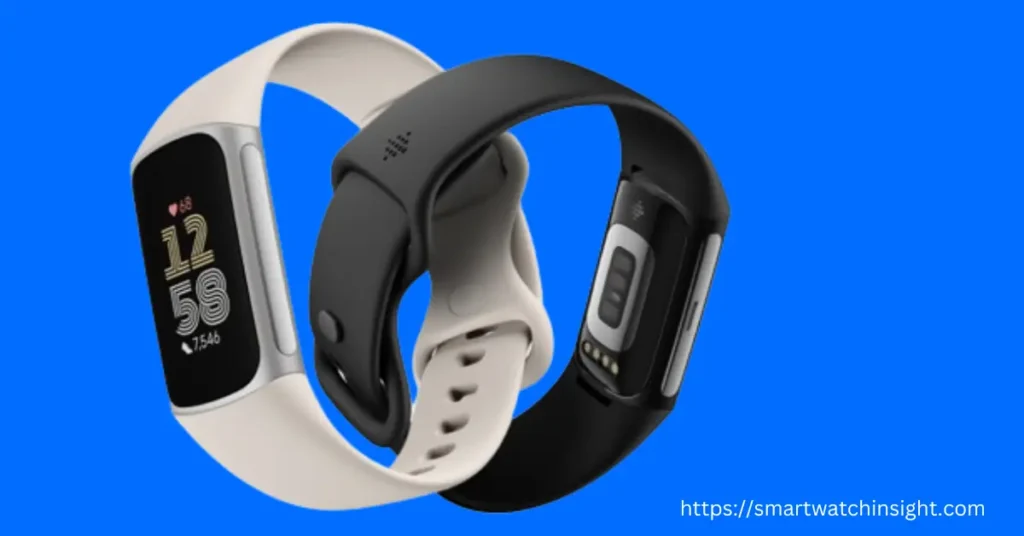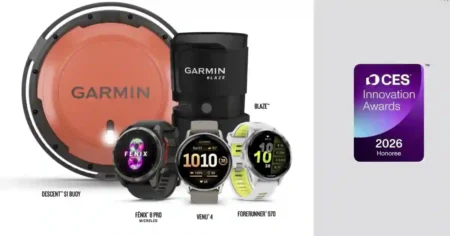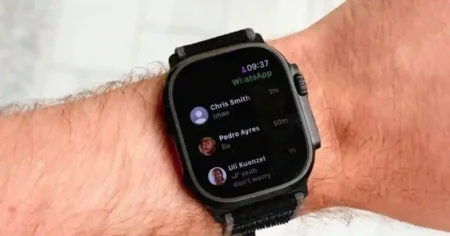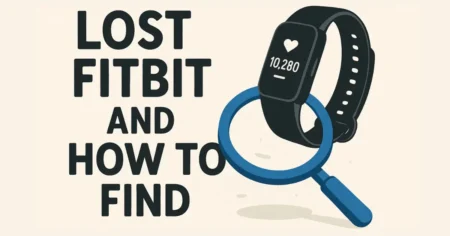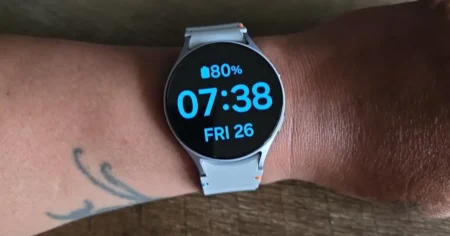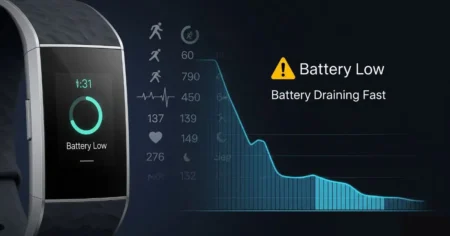Do you feel that your Fitbit is behaving abnormally or not functioning properly? Are you wondering if it’s time to replace it with a new one?
The blog is going to talk about 11 Signs That Tell You When It’s Time Your Fitbit Should Die. We’ll go in with you, whether you are due for a new upgrade or can still keep running on it.
By the end of this post, you’ll clearly understand the signs to look out for and the options available to you.
Related:-Fitbit Sense 2 is Now Available for $100 off: Amazon’s Best Deal
How to Know When Fitbit is Dying: Signs and Solutions
Fitbits are incredible companions for tracking your fitness and health, but like any device, they have a lifespan.
If your Fitbit isn’t performing as it used to, it might be a sign that it’s nearing the end of its life. Here’s how to tell if your Fitbit is dying and what you can do about it.
Life Span of Fitbit Tracker
Fitbit smartwatches have a commendable reputation for their quality and durability. On average, they last 16 to 18 months. Still, Fitbit watches outlast this benchmark, lasting approximately 2 to 3 years.
Their water-resistant design and high-quality construction ensure reliable and consistent performance throughout their initial two years. However, with diligent care and gentle usage, your Fitbit watch’s lifespan can be extended beyond the average expectation.
To increase the longevity of your Fitbit watch, it is essential to adopt routine cleaning practices and avoid exposing it to extreme temperatures and water. It is also necessary to keep a check on the battery’s performance, as it tends to diminish over time, influencing the overall lifespan of the device.
Fitbit provides a limited warranty covering manufacturing defects and malfunctions. However, users may be responsible for any necessary repairs or replacements once this warranty period concludes.
By following these measures and taking good care of your Fitbit watch, you can ensure its long-term durability.
How Long Does a Fitbit Last? And the Signs Your Fitbit is Dying
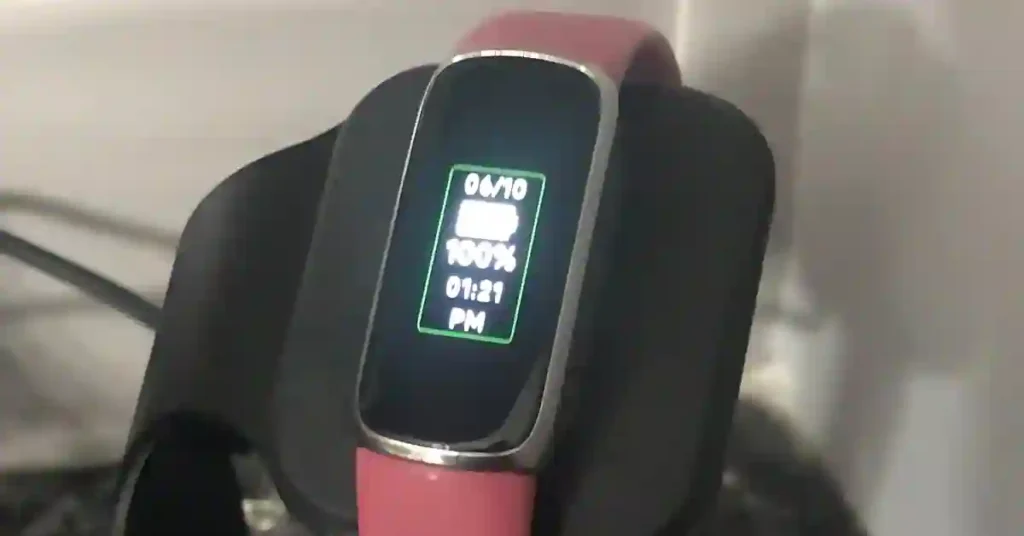
Fitbit users often wonder how they can tell if their Fitbit is dying. A few common issues may indicate that your Fitbit is on its last legs. Consider getting a new one if you’re experiencing any of these problems.
Here are 11 of the most common issues that can signal the end of your Fitbit’s life.
1. Unresponsive Buttons
Is pressing the buttons on your Fitbit starting to feel like a futile exercise? When your Fitbit becomes unresponsive or requires excessive force to register a press, it may be a sign that it’s reaching the end of its lifespan.
Often, this issue arises due to the accumulation of dirt, sweat, or moisture around the buttons. Attempting to clean the device might help, but if the problem persists, it might be time to consider a new Fitbit.
2. Poor Battery Life
One of the most frustrating signs that your Fitbit is on its last legs is a noticeable decrease in battery life. If you find yourself charging your Fitbit more frequently than before or it struggles to hold a charge for a reasonable amount of time, it could indicate that the battery needs to be fixed.
This problem can arise when batteries lose their ability to hold a charge, causing your Fitbit to die prematurely during the day.
3. Inaccurate Tracking
Fitbits are known for their precise tracking abilities regarding steps, heart rate, and sleep patterns. However, notice a sudden decline in the accuracy of your Fitbit’s readings.
It may be a sign that its sensors are failing or becoming less reliable. Inaccurate readings can impact your fitness goals and overall user experience, warranting severe consideration for a new Fitbit.
4. Display Problems
If your Fitbit screen shows signs of trouble, such as dead pixels, lines, or a dim display, it might be Time to say goodbye.
Display issues can hinder your ability to read essential information on your Fitbit, making it difficult to track your fitness progress or stay connected to notifications.
While some display issues may be fixable by troubleshooting, persistent problems could signal the need for a new Fitbit.
5. Slow Syncing or Connection Issues
Keeping your Fitbit synced is crucial to ensure that you have the latest fitness data and can access valuable insights.
If you are experiencing difficulties with syncing your Fitbit, such as frequent connection failures or longer-than-usual syncing times, it may be time to upgrade.
These connection problems could stem from outdated firmware, compatibility issues, or hardware constraints. It is essential to address these issues to ensure that you are getting the most out of your Fitbit and achieving your fitness goals.
6. Reduced Functionality
As your Fitbit device ages, it may start to experience a decline in functionality due to regular wear and tear. In case you notice that features or sensors on your Fitbit device are no longer working as they should, it could imply that your device is reaching the end of its life.
It means that you may need to start considering buying a new one to avoid any inconvenience. Reduced functionality can significantly impact your Fitbit experience, making it challenging to track your fitness goals accurately.
For instance, if the heart rate monitor is malfunctioning, you may not be able to monitor your heart rate accurately during exercise or daily activities. An unresponsive or glitchy touchscreen can also be a significant issue, making it difficult to navigate the device and access your fitness data.
Therefore, it’s essential to keep an eye on your Fitbit’s functionality and ensure that it’s working correctly. In case you notice any issues, you can contact customer support to find out if there is a solution.
If the device is beyond repair, you may need to start planning to buy a new one to continue enjoying the benefits of tracking your fitness goals accurately.
7. Physical Damage or Wear
Fitbits are designed to be durable and able to withstand the wear and tear of daily use. However, even with the best intentions, accidents can happen, and your Fitbit might suffer severe physical damage.
It can come in the form of a cracked screen, a broken strap, or exposure to water. Physical damage can be detrimental to your Fitbit’s ability to function correctly or keep up with your active lifestyle.
As a result, it may be necessary to consider replacing your Fitbit if it has encountered such damage. This will ensure that you have a reliable and functional device that can keep up with your everyday activities.
8. Outdated Software
Fitbit frequently launches software updates to improve its functionality, introduce new features, and fix any bugs.
However, as Fitbits get older, they may not be compatible with the latest software updates, which can result in fewer features and a less user-friendly experience.
If your Fitbit cannot update to the latest software version, it may be a sign that you should consider upgrading.
9. Discontinued Support and Accessories
Fitbit periodically discontinues support for older Fitbit models, removing them from the devices compatible with new features and services.
Additionally, discontinued Fitbit models may have limited availability of accessories such as replacement straps or chargers.
Find your Fitbit model is no longer supported, or you need help finding necessary accessories. TimTime may be moving on to a newer model.
10. Lack of Compatibility with New Devices
Fitbit often releases software updates to enhance its functionality, provide new features, and address any bugs.
However, as Fitbit devices become older, they may not support the latest software updates, resulting in a less user-friendly experience and fewer features.
If your Fitbit fails to update to the latest version of the software, it may be a sign that you should consider upgrading to a newer device.
11. Desire for New Features and Innovations
Fitbit, as a leading brand in the fitness tracking industry, is committed to introducing new models with advanced features and cutting-edge innovations.
If you find yourself wishing for additional parts to be added to your current Fitbit or attracted to the latest advancements, it may be a sign that it’s time to consider an upgrade.
By keeping up with the latest Fitbit offerings, you will have access to the most advanced tracking technologies and features, which can help you achieve your fitness goals more effectively.
Most Common Fitbit Problems and Their Solutions

Fitbit devices are known to be excellent fitness trackers, but even the best machines can sometimes have issues.
If you are a Fitbit user experiencing problems with your device, you should know you are not alone. There are several common problems that Fitbit users face, and here are some of the most frequently reported issues and their potential solutions.
1. Syncing Issues
One of the most common issues that Fitbit users face is syncing problems. If your device is not syncing with your phone or computer, there are several things you can do to fix the issue.
First, restart your Fitbit and phone to see if that resolves the problem. Also, ensure your phone’s Bluetooth is turned on and your Fitbit app is updated to the latest version.
If the issue persists, try removing and re-adding your Fitbit device, restarting the Bluetooth connection, or contact Fitbit Support for further assistance.
2. Battery Draining Quickly
Another common issue is a quick battery drain. When the battery is completely drained too fast, there are several steps you can take to extend its life.
First, reduce the screen brightness, limit notifications, and disable All-Day Sync, Quick View, and other unnecessary features. Ensure that your device is running the latest firmware, and if the issue persists, contact Fitbit Support for guidance.
3. Inaccurate or Irregular Heart Rate Tracking
The heart rate tracking feature is one of the most essential functions of a fitness tracker. Suppose you are experiencing inaccurate or irregular heart rate readings. In that case, there are several things you can do to fix the issue.
Ensure your device is snug on your wrist, clean the sensor and your skin, and avoid wearing the device over tattoos or scars. Try wearing the device higher on your wrist, updating the firmware, or contacting Fitbit Support for assistance.
4. GPS Not Functioning Properly
Suppose your device has GPS functionality, but it is not working correctly. In that case, there are several things you can do to troubleshoot the problem.
Ensure the device has a clear sky view, enable location services on your phone, update the Fitbit app and device firmware, and restart your phone and Fitbit. If the issue persists, contact Fitbit Support for further troubleshooting.
5. Display or Touchscreen Problems
Suppose you are experiencing problems with your device’s display or touchscreen. In that case, there are several things you can do to resolve the issue.
Clean the screen, ensure your hands are clean and dry, perform a restart or factory reset, and update the firmware. If the problem persists, contact Fitbit Support for guidance.
6. Strap or Band Issues
If you are experiencing problems with your device’s strap or band, there are several things you can do to fix the issue.
Ensure that the belt is fastened correctly, clean the strap regularly, replace worn or damaged straps with Fitbit-approved options, or contact Fitbit Support for assistance.
8. Charging Problems
If your device is not charging correctly, there are several things you can do to troubleshoot the problem. Clean the charging port and pins, try a different charging cable or adapter, ensure a secure connection, restart your Fitbit and charging device, or contact Fitbit Support for further troubleshooting.
It’s worth remembering that these solutions are general recommendations, and the specific steps may vary depending on the Fitbit model and situation. If the problem persists, it is advisable to consult the Fitbit website’s support section or reach out to Fitbit Support directly for personalized assistance.
How can I check my battery life?
Wondering how to check your Fitbit’s battery life? It’s super simple!
- On Your Fitbit: Swipe the screen or press the button (depending on your model) to find the battery icon.
- Via the Fitbit App: Open the app, tap your profile picture, select your device, and the battery percentage will be displayed.
- While Charging: When you connect your Fitbit to the charger, the screen will show its current battery level.
These methods make it easy to keep track of your Fitbit’s charge!
How do you know if your Fitbit needs a new battery?
If you think your Fitbit might need a new battery, here are some simple signs to look out for:
1. Battery Drains Quickly
If your Fitbit’s battery used to last several days and now only lasts a day or two, it’s a sign the battery might be wearing out.
2. Trouble Charging
If your Fitbit takes a long time to charge or doesn’t charge fully, the battery could be the issue. You might also notice that the battery level jumps around or doesn’t show the correct amount.
3. Turns Off Unexpectedly
If your Fitbit turns off by itself, even though it says the battery isn’t empty, the battery might not be working properly anymore.
4. Gets Hot While Charging
If your Fitbit gets warm or hot when it’s charging, it might mean the battery is failing and needs to be replaced.
5. Battery Doesn’t Hold a Charge
If your Fitbit charges to 100% but quickly drops back down, it’s a clear sign the battery isn’t holding power like it used to.
6. Your Fitbit is Old
If your Fitbit is a few years old, the battery might just be getting old. All batteries wear out over time, and after a few years, it might be time to replace it.
What You Can Do:
Restart Your Fitbit: Sometimes, turning your Fitbit off and back on can help. If the battery still drains fast, it might need more than a restart.
Update the Software: Make sure your Fitbit has the latest updates, as these can sometimes help with battery problems.
Replace the Battery: If these tips don’t help, it might be time to get a new battery. Some Fitbits let you replace the battery, but for others, you might need to get a new device.
If your Fitbit is showing these signs, it’s likely that the battery is getting old and may need to be replaced. You can try restarting or updating your Fitbit, but if the problems continue, a new battery or device might be the best solution.
Conclusion: Is your Fitbit Dying
Knowing when to retire your Fitbit can be a challenging decision. However, by paying attention to these 11 warning signs, you’ll have a better understanding of whether it’s time to get a new Fitbit.
Whether your Fitbit has unresponsive buttons, poor battery life, or you desire new features, every Fitbit user eventually comes to this crossroad.
Take a moment to evaluate your Fitbit’s condition and decide what fits your needs and aspirations best. Don’t let outdated technology hold you back on your fitness journey. It’s time to leap and invest in a new Fitbit that will empower you to achieve your goals and track your progress like never before.
You May Also Like:-
FAQs: Fitbit is Dying
Q. Why is my Fitbit Dying so Fast?
Fitbit devices may die quickly due to factors like constant syncing, high notification volume, continuous heart rate monitoring, GPS usage, outdated software, background apps, overcharging, or excessive display brightness. To address the issue, adjust syncing and notification settings, update firmware and apps, manage GPS and heart rate monitoring, avoid overcharging, and optimize display brightness. If problems persist, contact Fitbit support.
Q. What is the typical lifespan of a Fitbit?
The lifespan of a Fitbit can vary, but you can expect it to last around 2-4 years with normal use. Some factors like model, usage, and care can affect how long it lasts. If your Fitbit starts showing signs like shorter battery life, performance issues, or physical damage, it might be getting older.
Remember, you don’t need to rush into replacing your Fitbit if it’s still working well for you. But if you’re experiencing problems or it’s not meeting your needs anymore, it might be time to consider an upgrade.
Taking good care of your Fitbit by keeping it clean, avoiding extreme temperatures, and updating the software can help it last longer.
q. What Do I Do When My Fitbit Battery Dies?
First, when one’s Fitbit is running out of battery, it is much better to charge it using an original charger. The clean and properly aligned charging contact of both the Fitbit device and the charger itself provides good electrical contact. Connect that to a working USB port or into a wall adaptor and then check the glowing of lights or other lighting-up options like the showing of the battery icon for any charging indication. If nothing happens, try moving to a different USB outlet or using another charger. Restarting your Fitbit Sometimes, just clearing the petty issues that could cause everything to stop working requires anything as simple as holding a button down for a few seconds while it’s connected to power.
If it’s the case that your Fitbit is charging but the battery isn’t lasting long, then you can make some settings changes to have it last a little longer. Lower screen brightness, turn off any feature you don’t use such as GPS or Wi-Fi, and reduce notifications. Checking for software updates in the Fitbit app also can’t hurt; old firmware can sometimes cause odd battery behavior.
Note that in the case of further issues that may not be resolved with the mentioned steps, reaching out for Fitbit support would not go amiss, considering your device might still fall within the warranty period. This may be an opportunity for further assistance, a repair, or even a replacement. In such a scenario that the battery has worn out, a non-warranty, current-generation Fitbit will need to be professionally replaced because this is work one does not do easily. Good care and proper charging prevent battery problems.

